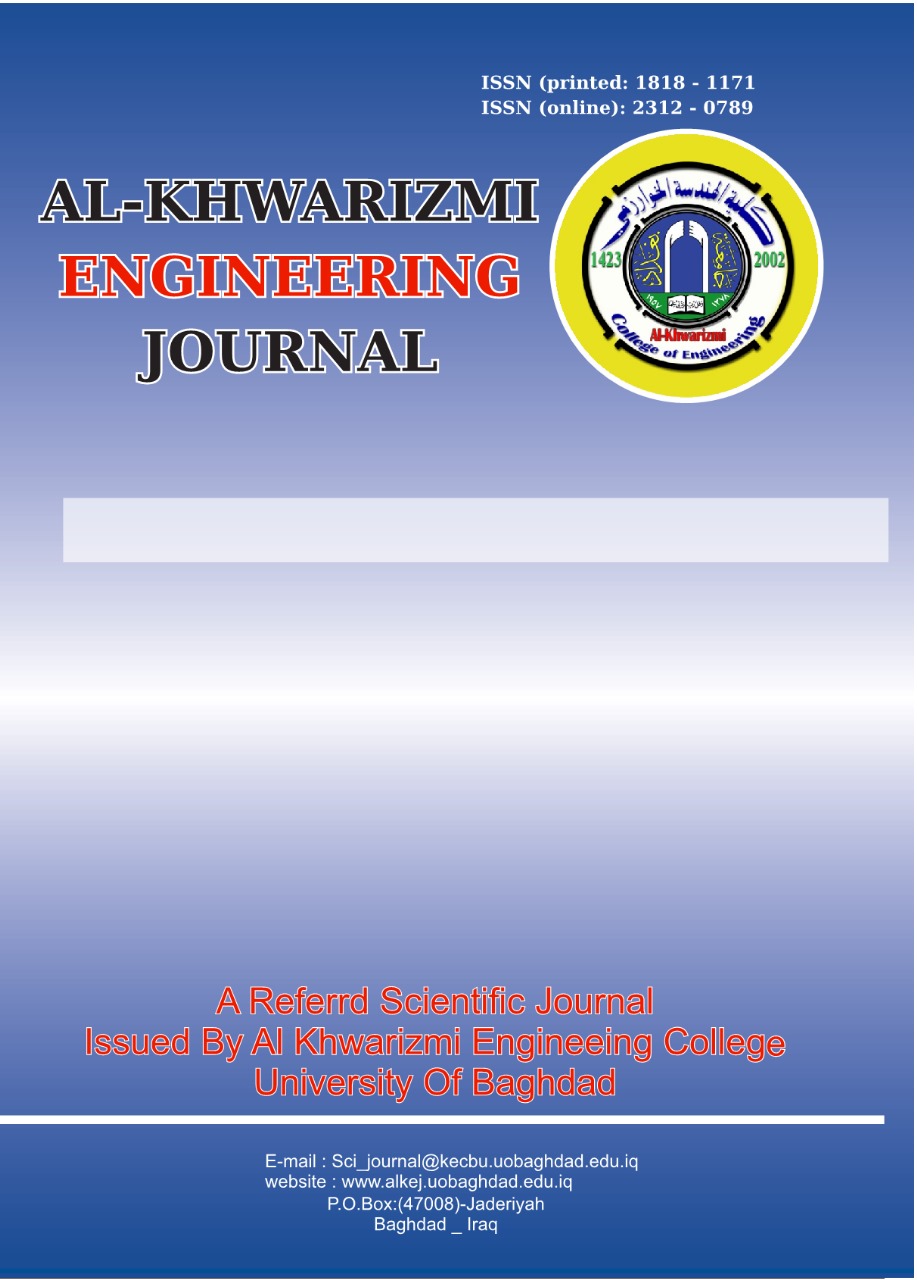دراسة أداء خلية تحلية المياه الميكروبية؛ كفاءة توليد الطاقة وتحلية المياه باستخدام الأكسجين النقي في غرفة الكاثود
DOI:
https://doi.org/10.22153/kej.2022.07.002الملخص
الخلاصة
خلية التحلية الميكروبية (MDC) قادرة على تحلية المياه المالحة وإنتاج الطاقة الكهربائية ومعالجة مياه الصرف الصحي. في السابق، تم استخدام الكاثود الكيميائي، والتي كانت مقيدة في التطبيق بسبب ارتفاع تكاليف التشغيل وانخفاض مستويات الاستدامة والسمية العالية. تم استخدام كاثود أكسجين نقي ودرس المقاومة الخارجية 50 و150 (كيلو أوم) بتركيزين في غرفة التحلية 15-25 (جم / لتر) والتي تمثل تركيز المياه قليلة الملوحة ومياه البحر باستخدام عملية الخلط في غرفة التحلية. أعلى توليد للطاقة تم الحصول عليه هو 48 (ملي وات / متر مكعب) وكان الحد الأقصى لتحلية المياه للمياه المالحة 55٪ ولمياه البحر 40٪ لمدة 48 ساعة من وقت التشغيل. أظهرت هذه الدراسة نهجاً واعداً لاستخدام عملية الخلط في غرفة التحلية من أجل زيادة إنتاجية التحلية والكهرباء.
التنزيلات
المراجع
A. E. Atabani, I. A. Badruddin, S. Mekhilef, and A. S. Silitonga, “A review on global fuel economy standards, labels and technologies in the transportation sector,” Renew. Sustain. Energy Rev., vol. 15, no. 9, pp. 4586–4610, 2011, doi: 10.1016/j.rser.2011.07.092.
H. H. Abd-almohi, Z. T. Alismaeel, and M. J. M-Ridha, “Broad-ranging review: configurations, membrane types, governing equations and influencing factors on microbial desalination cell technology,” J. Chem. Technol. Biotechnol., Jun. 2022, doi: 10.1002/JCTB.7176.
R. Semiat, “Critical Review Energy Issues in Desalination Processes,” Am. Chem. Soc., vol. 42, no. 22, pp. 8193–8201, 2008.
Z. T. Alismaeel, A. H. Abbar, and O. F. Saeed, “Application of central composite design approach for optimisation of zinc removal from aqueous solution using a Flow-by fixed bed bioelectrochemical reactor,” Sep. Purif. Technol., vol. 287, no. January, p. 120510, 2022, doi: 10.1016/j.seppur.2022.120510.
D. R. Saad, Z. T. Alismaeel, and A. H. Abbar, “Cobalt Removal from Simulated Wastewaters Using a Novel Flow-by Fixed Bed Bio-electrochemical Reactor,” Chem. Eng. Process. - Process Intensif., vol. 156, no. August, p. 108097, 2020, doi: 10.1016/j.cep.2020.108097.
V. G. Gude, “Desalination and sustainability - An appraisal and current perspective,” Water Res., vol. 89, pp. 87–106, 2016, doi: 10.1016/j.watres.2015.11.012.
J. P. Chen, L. K. Wang, L. Yang, and Y. Zheng, Membrane and Desalination Technologies, vol. 13. 2011. doi: 10.1007/978-1-59745-278-6.
C. Forrestal, P. Xu, P. E. Jenkins, and Z. Ren, “Microbial desalination cell with capacitive adsorption for ion migration control,” Bioresour. Technol., vol. 120, no. September, pp. 332–336, 2012, doi: 10.1016/j.biortech.2012.06.044.
H. Wang and Z. J. Ren, “A comprehensive review of microbial electrochemical systems as a platform technology,” Biotechnol. Adv., vol. 31, no. 8, pp. 1796–1807, 2013, doi: 10.1016/j.biotechadv.2013.10.001.
X. Cao et al., “A new method for water desalination using microbial desalination cells,” Environ. Sci. Technol., vol. 43, no. 18, pp. 7148–7152, 2009, doi: 10.1021/es901950j.
M. Mehanna et al., “Using microbial desalination cells to reduce water salinity prior to reverse osmosis,” Energy Environ. Sci., vol. 3, no. 8, pp. 1114–1120, 2010, doi: 10.1039/c002307h.
K. S. Jacobson, D. M. Drew, and Z. He, “Efficient salt removal in a continuously operated upflow microbial desalination cell with an air cathode,” Bioresour. Technol., vol. 102, no. 1, pp. 376–380, 2011, doi: 10.1016/j.biortech.2010.06.030.
X. Chen, X. Xia, P. Liang, X. Cao, H. Sun, and X. Huang, “Stacked microbial desalination cells to enhance water desalination efficiency,” Environ. Sci. Technol., vol. 45, no. 6, pp. 2465–2470, 2011, doi: 10.1021/es103406m.
Z. He, N. Wagner, S. D. Minteer, and L. T. Angenent, “An upflow microbial fuel cell with an interior cathode: Assessment of the internal resistance by impedance spectroscopy,” Environ. Sci. Technol., vol. 40, no. 17, pp. 5212–5217, 2006, doi: 10.1021/es060394f.
Q. Wen, H. Zhang, Z. Chen, Y. Li, J. Nan, and Y. Feng, “Using bacterial catalyst in the cathode of microbial desalination cell to improve wastewater treatment and desalination,” Bioresour. Technol., vol. 125, pp. 108–113, 2012, doi: 10.1016/j.biortech.2012.08.140.
K. S. Jacobson, D. M. Drew, and Z. He, “Use of a liter-scale microbial desalination cell as a platform to study bioelectrochemical desalination with salt solution or artificial seawater,” Environ. Sci. Technol., vol. 45, no. 10, pp. 4652–4657, 2011, doi: 10.1021/es200127p.
H. Luo, P. E. Jenkins, and Z. Ren, “Concurrent desalination and hydrogen generation using microbial electrolysis and desalination cells,” Environ. Sci. Technol., vol. 45, no. 1, pp. 340–344, 2011, doi: 10.1021/es1022202.
Y. Kim and B. E. Logan, “Series assembly of microbial desalination cells containing stacked electrodialysis cells for partial or complete seawater desalination,” Environ. Sci. Technol., vol. 45, no. 13, pp. 5840–5845, 2011, doi: 10.1021/es200584q.
M. Mehanna, P. D. Kiely, D. F. Call, and B. E. Logan, “Microbial electrodialysis cell for simultaneous water desalination and hydrogen gas production,” Environ. Sci. Technol., vol. 44, no. 24, pp. 9578–9583, 2010, doi: 10.1021/es1025646.
L. Huang, X. Chai, G. Chen, and B. E. Logan, “Effect of set potential on hexavalent chromium reduction and electricity generation from biocathode microbial fuel cells,” Environ. Sci. Technol., vol. 45, no. 11, pp. 5025–5031, 2011, doi: 10.1021/es103875d.
X. Zhang, W. He, L. Ren, J. Stager, P. J. Evans, and B. E. Logan, “COD removal characteristics in air-cathode microbial fuel cells,” Bioresour. Technol., vol. 176, pp. 23–31, Jan. 2015, doi: 10.1016/J.BIORTECH.2014.11.001.
التنزيلات
منشور
إصدار
القسم
الرخصة
حقوق الطبع والنشر: يحتفظ مؤلفو الوصول المفتوح بحقوق الطبع والنشر لاعمالهم، ويتم توزيع جميع مقالات الوصول المفتوح بموجب شروط ترخيص Creative Commons Attribution License، والتي تسمح بالاستخدام غير المقيد والتوزيع والاستنساخ في أي وسيط، بشرط ذكر العمل الأصلي بشكل صحيح. إن استخدام الأسماء الوصفیة العامة، والأسماء التجاریة، والعلامات التجاریة، وما إلی ذلك في ھذا المنشور، حتی وإن لم یتم تحدیدھ بشکل محدد، لا یعني أن ھذه الأسماء غیر محمیة بموجب القوانین واللوائح ذات الصلة. في حين يعتقد أن المشورة والمعلومات في هذه المجلة صحيحة ودقيقة في تاريخ صحتها، لا يمكن للمؤلفين والمحررين ولا الناشر قبول أي مسؤولية قانونية عن أي أخطاء أو سهو قد يتم. لا يقدم الناشر أي ضمان، صريح أو ضمني، فيما يتعلق بالمواد الواردة في هذه الوثيقة.















